This essential guide will teach you the ins and outs of poker ranges, like reading opponents and constructing your own ranges.
With practical examples and expert insights, you'll refine your strategy, adapt to various opponents, and dominate the tables.
Here’s what you’ll learn:
Whether you're a novice or a seasoned player, this comprehensive guide on poker ranges will undoubtedly enhance your skills and increase your chances of success.
So shuffle up, deal yourself in, and prepare to level up your poker game!
I want you to imagine a special pair of poker-playing glasses.
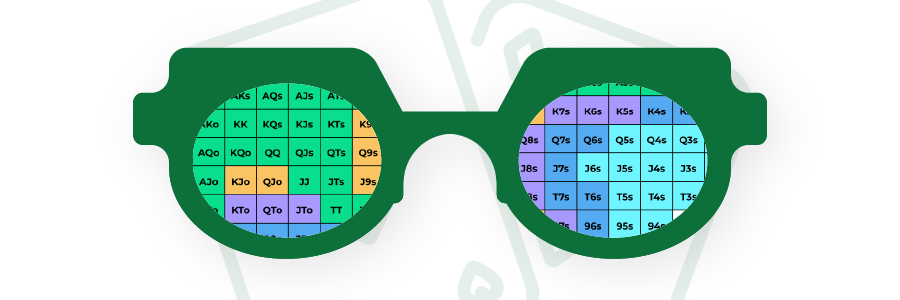
When you wear them, you can see your opponent’s hole cards. It would be a fantastic advantage, wouldn’t you say?
I’m sorry to say that even if these glasses did exist, it would be cheating to wear them, as it would give you an unfair advantage over your opponents.
Even so, there are things you can do to approximate the advantage these glasses would give you by estimating the cards your opponents are likely to have, helping you figure out the best way to play against them.
When you make that estimation, you identify the range of hands your opponent may be playing. The process of assigning them this range of hands is said to be ranging your opponent.
Pro tip
Are you completely new to the game? Check out my full poker guide for beginners and master the basics before diving into the more advanced concepts like ranges.
Beginning and casual players typically think only about their hand and its strength. They hold a flush and think they have a strong hand.
They might have said, “Well, I know I’m probably beaten – but I can’t fold a flush!”
And so they call – and lose.
Serious and good players know that their hand strength can only be evaluated correctly concerning their opponent’s hand.
The flush is a trash hand if your opponent is likely to have a full house.
Though you may only have Queen-high, your hand has value if your opponent is likely to hold a Jack-high or weaker.
To move from the ranks of the beginning player to that of a winning player, you must consider your opponent’s hand and your own. Understanding hand ranges helps you do that.
In the old days, before 2010 or so, when considering what an opponent was likely to have, players didn’t use the term “range.” Instead, they thought about “putting someone on a hand.”
This meant figuring out the exact hand their opponent had. It was indeed helpful, but it was inadequate, as such a fine distinction could rarely be accurately made.
Modern poker thinking recognizes that thinking of all possible hands that an opponent will likely play makes more sense.
That group of likely hands is known familiarly as their “range.” And the study of that range is known as “range analysis.”
Before learning to analyze range, we need to see how ranges are expressed in written form. There are a few ways.
We can write out each of the 1326 combinations of two cards a player may hold. Each of these hands can be expressed with the symbol for each card, for example, Kh Js, 7s 7c, Qd 4d, etc.
These are each known as combos.
When we write out all the hands an opponent is likely to be playing, using the symbols for the hands introduced in our beginner’s outline, this is known as a range strand. It often uses some abbreviated symbols for the hands.
Example 1
If you wanted to write all of the pairs 66 and higher, instead of writing out each combo that makes up those pairs, you’d write 66+. For all of the suited cards T9 and higher, you’d write T9s+.
If you wanted to write every AK, both suited and unsuited, you’d write simply AK. A strand puts all of these symbols together.
Example 2
If you wanted to express a range that includes all the combos in TT, JJ, QQ, KK, AA, AJ, AQ, and AK, the range strand would be written in the abbreviated form: TT+, AJ+.
Simple, yes?
Another way of expressing a range is in terms of percentage.
You would refer to the percentage of all 1326 combos an opponent will likely be playing.
Example 3
If you were identifying a typical player’s opening range in the middle position, you might say they were playing a range of 20%.
Based on your read of this opponent, their position, and their betting action, their range was the 20% strongest hands of the 1326 possible hand combinations.
Finally, ranges can be expressed on a range matrix (a.k.a. grid or chart). This is a 13 x 13 matrix with 169 cells representing similar combos.
The cell of AA, for example, represents all of the six combos for AA: AhAs, AhAd, AhAc, AsAd, AsAc, and AdAc.
Let’s look at this range matrix more closely.
Download the Poker Range Sheet
As we mentioned, each cell in the matrix represents all similar combos, identified by the alpha-numeric symbol for the hand.
Running diagonally down the middle are the pairs. They start with AA in the top left corner and descend to 22 in the bottom right.
The suited hands are on the top right half of the chart; on the bottom left are the unsuited hands. They run from left to right and from top to bottom in descending order.
Take a few minutes to familiarize yourself with this chart. Try finding a few hands.
- Find 77.
- Find T3o.
- Find J9s.
Though the matrix may appear daunting initially, it’s pretty simple to use once you get the hang of it. It is an invaluable tool.
If you could see your opponent’s hand, you could fully exploit their play. You’d know when they were bluffing and betting for value.
You’d know when their hands were weak, and you could get them to fold with a bluff, and when they were solid, you could correctly fold to their bet.
With complete knowledge of their hands, you can accurately determine their drawing odds and your drawing odds to beat them.
Similarly, though you won’t know with certainty what your opponent holds, you can exploit an opponent by putting him/her on a range of hands. Though ranging is based on an educated inference rather than actual knowledge, it allows you to exploit their play as the hand develops.
You will better decide where you stand pre-flop; whether the flop, turn, and river help them; and whether they are value betting or bluffing.
You will then be able to determine your best betting action.
The more accurate you are at ranging your opponent, the better able you’ll be at exploiting them.
Realize that your better opponents are doing the same to you – trying to figure out your range to exploit you.
If you proceed in a modern poker game without considering your opponent’s range, you are going into battle unarmed.

When a poker hand is first dealt, our opponent’s range is 100%. That is, there is an equal chance that they have any one of the 1326 possible two-card combos.
They are just as likely, or unlikely, to be dealt Ac-As as 7h-2s.
Assuming a complete deck and honest dealing, all hands are equally likely to be dealt to each player since the initial distribution of the cards is entirely random and unknowable.
But that changes as soon as there is betting action, as a player’s behavior starts to define the hands they are likely to hold.
As a general rule of thumb, a player who raises, 3-bets, or otherwise augments betting action is expected to have a stronger hand than a player who folds or limps.
Be aware
This is not always the case, as players are allowed to act irrationally. And they are allowed to disguise their hands with bluffing and slow-playing. Nothing prevents a player from shoving all in with 72o if they want or limping with AA, for that matter. But, as poker is a game of probability, not certainty, we assume rational and straightforward play when figuring out an opponent’s range.
As the hand progresses and more betting action is introduced, we can further narrow the range of hands they are likely to have.
We can thereby use these actions to infer the strength of their hand – eliminating weak hands from their playing range.
Similarly, we can use their position to define their range further.
A player raising in an early position is likely to have a hand that is stronger than a player who is raising in a late position.
We can further define their range by considering the type of player they are. Loose players tend to play more hands than tight players.
So a raise from a tight player, especially in an early position, would indicate a much narrower range than a very loose player in a late position.
By considering the type of player we are against, their position, and their betting action, we can define the range of hands an opponent will likely be playing.
Assign a Range to Your Opponent
Ranges are neither immutable nor universal.
They differ from one player to the next and from one betting position to the next.
How do you correctly infer the correct range of your opponent?
Theoretically, you could range your opponents based on the hands they revealed at showdown. If you could see a few hundred hands for each player, played from each position, you could get a good read on precisely what hands each opponent tended to play.
However, given how few hands each participant plays all the way to a showdown during a playing session, from each position, no less, such an exercise would probably be impractical.
You would never see enough hands to assemble such data on your own.
Instead, it makes more sense to infer a player’s range by starting with the percentage of hands they are likely to be playing – and then seeing what the strongest hands are within that percentage of hands.
For example
We’d start with the percentage most players tend to open with from each position in determining an open-raising range.
Once you have that, you would adjust it upwards or downwards, based on the type of player you were playing, based on their position, and then based on the betting action they took.
This requires us to start with and define a typical range. One way is to start with yourself. True, other players don’t necessarily play precisely like you.
But your play provides a good starting point.
How to Find Your Range
To determine your range, consider what hands you typically open with from each betting position: early, middle, late, button, and blinds.
- With which hands do you limp?
- What hands do you typically 3-bet?
Then think of yourself and your playing style compared to others.
- Are you tighter than average?
- Looser than average?
- About in the middle?
Interactive range matrices allow you to plug in your data.
- Start with your opening range.
- Select the hands you typically open from different positions, and see what percentage of the entire matrix they represent.
- Do you usually open with 10% of the combos in early position? 15% in mid position? 25% on the button? Go through each position and do this. Write down the results.
Considering your playing style, change that range to fit a more typical player.
If, for example, you think you are tighter than usual, you’d want to broaden your range when coming up with the range of a typical opponent.
If you tend to be looser than what you consider typical, you will narrow the range to come up with the range of an ordinary opponent.
Consider the Standard Opening Range Percentages
You can also rely on some time-honored percentages that define a typical player.
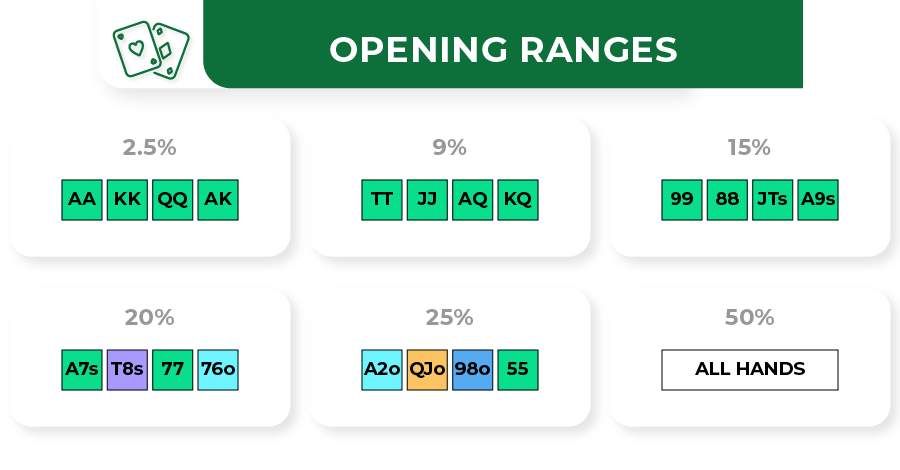
Conventional wisdom is that a standard opening range from the middle position for the regular player is the 15% strongest hands.
Some may disagree, but this corresponds with my observations as well. Early position is a smaller percentage.
A tight player might only raise from early position with 2.5% of all hands from early position. Late position may expand that typical raising percentage to 25% or 30%.
Loose players may raise with more than 50% of all hands in late position or the blinds.
Learning what hands are in this typical opening range would be best.
You can do that by looking at interactive range charts where you can highlight all the hands in a range, based on the percentage of hands they represent.
Notice what hands are in each.
You’ll see, for example, that a player opening only with 2.5% of their hands has a range of just QQ+ and AK. A 9% range includes pocket pairs down to 66 and a lot more Broadway hands than the more narrow range.
Notice the other ranges and the hands they are likely to include.
Adjust ranges for position and opponent’s playing style
Now think about specific opponents in specific positions.
Consider the range for tight players. Maybe, instead of opening with 15% of the hands in the middle position, they would only open with 5% or 10% of the hands.
Now imagine that a tight player is opening in early position. They’re probably not playing more than 2.5% of the hands.
Plug that in and see the few hands that they are likely raising with. It’s only QQ+ and AK.
Compare the Value of Your Hand versus your opponent’s likely range.
We need to know how our hand does in a showdown against our opponent’s likely range, not just against one particular hand, but against all the hands they might be playing.
This informs our play and can help us devise a profitable playing line against our opponent.
For example
Imagine we are playing with JJ against a very tight player UTG. He raises. We’d put him on that extremely narrow 2.5% range: AA, KK, QQ, and AK.
Before we decided on our strategy against the raiser, we’d want to know how our JJ did against Villain’s narrow range.
To do this accurately, we’d need to correctly identify all the combos in our opponent’s range. There are 16 AKs (4 suited and 12 unsuited) and 18 pairs (6 AA, 6 KK, and 6 QQ).
We are very slight favorites against the 16 AK hands and massive underdogs against the 18 pairs. (Our best move would probably be to fold, though if stacks were big enough, we might call, with a plan of folding on the flop if we didn’t hit our set.)
Now, imagine a different scenario, one that is more complex.
We have As Js in late position, and our moderately loose opponent raises in middle position. Instead of an extremely narrow range of only 2.5% of hands, we infer that our opponent is opening with a range of 15% of all combos.
How does our As Js do against all of the combos in that range?
The answer is more challenging to figure out. We can’t, in our head, compare our hand to each of the many combos in our opponent’s range. There are just too many combos to compare. That’s where a range equity calculator comes into play.
A range equity calculator is a great tool. It does the computation for you, working just like the odds calculators of old, but against all of the hands in your opponent’s entire range.
Odds calculators pitted individual hands against other hands to determine what percentage of the time each hand would tend to win at showdown.
- AA vs. JJ? Roughly 80%.
- AK vs 77? Roughly 47%.
These are the figures you see displayed on televised poker shows.

With a Range Equity Calculator, we’re measuring the odds that our hand will win against the entire range of our opponent’s possible hands, determining how many combos there are for each hand.
In this example, holding As Js, against a range of 15%, you’d likely be against: 66+, A5s+, K9s+, QTs+, JTs, ATo+, and KTo+. Using a range equity calculator you would see that your As Js would win at showdown 50% of the time against this range.
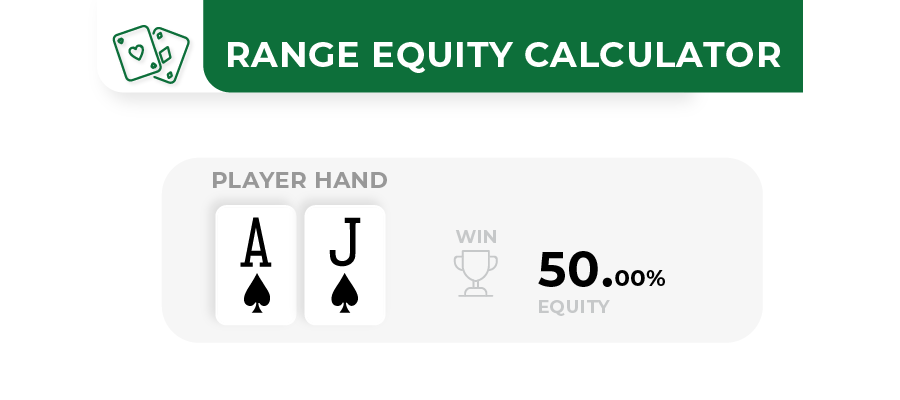
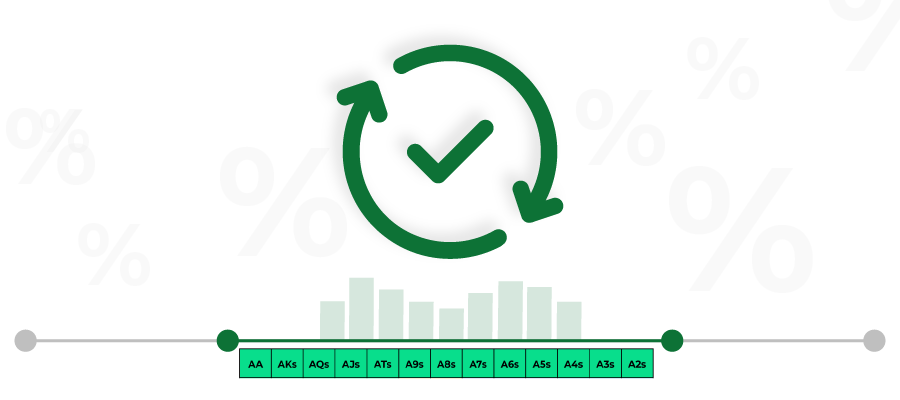
We should update our estimation of the opponent’s range as the hand progresses. Just as we would use an opponent’s action pre-flop to help define their range, so too would we use the cards on the board and their action post-flop to further define their range.
Imagine that a very tight player raises in early position, and you call. You should think they have a range of big pairs, AK and maybe AQ. The flop is J 9 2 rainbow and your opponent checks. You’d have to update your estimate of his range. It’s much more likely that he has AK or AQ than AA, KK, or QQ.
You should narrow their range accordingly.
As you become comfortable with ranging your opponents, you want to individualize your ranges to account for the particular type of player you are against, and the variety of situations they will be in that might affect their range. Some of these account for rational differences among players. And some are factors that cause players to deviate from their typical ranges.
We’ll start with the sensible factors.
Relative Tightness and Looseness

Give tight players a smaller range, subtracting some hands that a looser player might be playing. For example, some players may be raising with any two cards.
Other players are only going to raise with big pairs and AK. You can play a much broader range against loose players than tight players.
Their Level of Passivity and Aggression
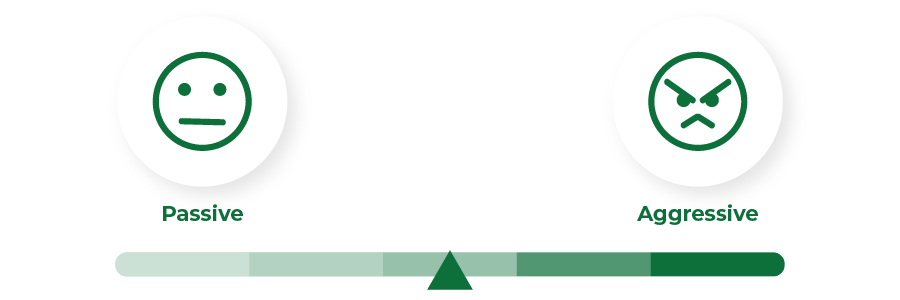
Some players limp with a broad range but raise with a very tight range. You need to factor that in when deciding whether to play against them.
Similarly, your 3-betting range will vary considerably against a player who can raise and fold to a 3-bet. Some players can; others can’t.
Your Image And Whether Your Opponent Is Likely to Notice It.

If you have a very tight and conservative image, your opponent may well open a broader range of hands in front of you, expecting you to fold all but a small percentage of your hands.
Similarly, they will likely fold a very high percentage of their raising range to a 3-bet from you.
But this is only true if they know enough to notice your image.
Advanced ranging requires that you consider not just the type of opponent you are facing but the situation you and they are in at the table.
Many players, especially those who are not professionals or experts, are affected by irrational factors. Here are 5 of the most common one you can use in your range analysis.
1. Whether they have won a lot or lost a lot of money during this session.

Some players tend to play more loosely and aggressively when they are ahead and more tightly and timidly when behind.
When this is the case, they tend to broaden their range when these players appear ahead for the session; and narrow their range when they seem to be underwater. (On the other hand, some players tend to sit on their gains after they have made a big score. When that’s the case, narrow your opponent’s playing range.)
2. Whether they won the last hand or the last few hands they entered
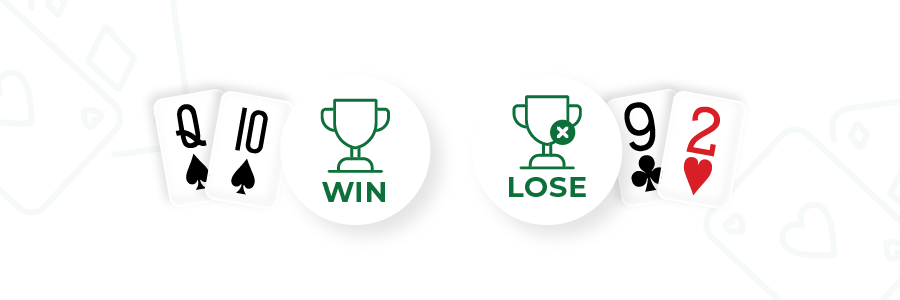
Some players irrationally think that their recent success or failure indicates how they are running. They “play their rushes” and avoid action when “running bad”.
While winning and losing streaks are unknowable, except in hindsight, superstitious or otherwise irrational opponents often narrow their ranges based on whether they think the poker gods are favoring or cursing them. Please consider this when you are estimating their range.
3. Whether they are soon to be leaving the game
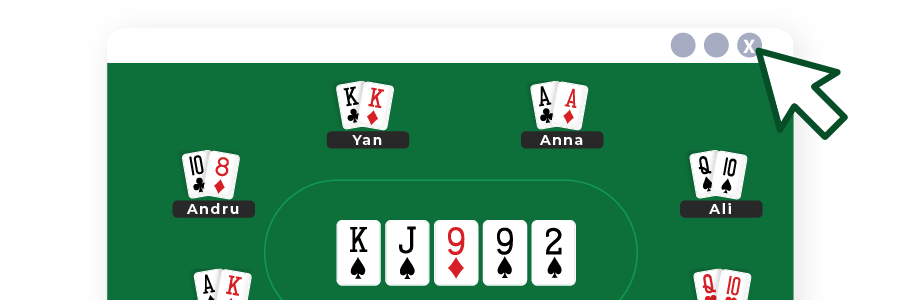
Many players – I would go so far as to say most players – play more tightly and conservatively when they are about to leave the game – especially if they are even for their playing session.
They may be playing around with their blind as they prepare to leave, and they’re just seeing if they get a strong hand before they go. If so, they tend to be highly unlikely to enter a hand unless they are solid. Tend to significantly shrink their playing range when this is the case.
4. Whether they are distracted from the game

Sometimes, players are not giving full attention to their poker game.
They may be conversing, watching a sporting event on TV, or even playing another game or video on their electronic device. When this is the case, they tend to shrink their range. They will be much less likely to want to enter the hand unless they perceive themselves to have a significant advantage from the get-go.
5. Whether they are playing a short stack

Many players play their short stack in a cash game much as they would in a tournament – with an increased willingness to shove their stack and take their chances.
When this appears to be the case, significantly broaden their raising range. They may be shoving with hands they would never open with if they were playing their typical starting stack or larger.
HUD is an acronym that stands for Head-Up Display.
It is a valuable tool for online poker, as it provides you with information about your opponents in real-time while you are playing, displaying the information on your screen next to the icon for each opponent.
It contains information about your opponent, based on the hands you have played against them. It saves information during and after each session and then makes it available whenever you play in the future.
There are dozens of statistics available from any of the many HUDs on the market. One of your first challenges in using a poker HUD will be deciding what information you want to be displayed.
The 3 most popular and most useful statistics are:
- VPIP (Voluntary Puts $ Into Pot)
- PFR (% of the time they enter the pot for a raise)
- total hands, indicating how many hands you have played against them.
But there are dozens of others you might use, including their aggression factor, the percentage of times they 3-bet or fold to 3-bets, or how often they make a continuation bet on the flop.
Any statistic you want about your opponent’s play can be available on a HUD. These stats give you a numeric picture of the type of player you are up against.
This is useful for many reasons, as you can imagine. Concerning range, it will help you figure out their likely range in different situations.
For example
An opponent with a high VPIP tells you your opponent will likely be very loose. If he has a high PFR, he is most likely very aggressive. Put those together, and you have someone likely playing an extensive range of hands and playing it aggressively – known as a LAG. Similarly, someone with a very low VPIP is expected to be very tight and be playing a much narrower range.
As you review these statistics, keep an eye on how many hands have gone into assembling the data.
It’s your sample size.
The smaller the sample, the less reliable and less usable the data. If, for example, you’ve only played 20 hands against someone, their extremely low VPIP may not indicate anything about their style of play.
They may just have had a string of bad hands. As a general rule, tend not to value statistics based on fewer than 50 hands and value statistics more the more significant the number of hands you’ve played against a player.
Know Thy Self
HUDs display statistics useful in helping you get a bead on your opponents’ play. But there’s another feature in these programs that you may find even more helpful.
That is their aggregation of your own playing statistics.
You can use them to review how often you are entering the pot, being the aggressor, folding to pressure, etc.
And, unlike statistics on your opponents, statistics about yourself can include information on all the hands you’ve been dealt, including the folded hands.
So you can see at a glance not just the percentage of hands you’ve played and folded but precisely what those hands were, how you played each of them, and how much you won or lost with them from each position.
This will give you an objective picture of your style of play.
Make sure you take full advantage of these features for self-discovery and improvement.
To develop expert poker skills, you’ll need to do a rigorous analysis of the hands you have played.
I call that analysis the Five Rs: Remember, Research, Reflect, Revise, and Re-apply.
During the play of the hand, you often have to make quick decisions, relying on your intuition to decide on your best action.
The tools of full-hand analysis won’t be available to you while you are playing. Complete analysis requires too much data to be done instantaneously during the play of a hand.
For practical purposes, you can only accurately determine your ideal betting action in different situations by analyzing your hand away from the table.
Consider that your homework.
It’s not the Reading, Rittin, and Rithmetic of elementary school, but rather the Five Rs: Remember, Research, Reflect, Revise, and Re-apply
Remember

You must first remember the hand you played – both your cards and your villain’s cards.
This means recording the specifics for later study. Don’t rely on your memory. During the play of the hand, take good notes.
Online poker sites and HUD programs come with note-taking features that you can use for this purpose.
You can also get an app for your electronic device or go old school and use a pen and piece of paper at the table.
Research

It would help if you then research the matter more closely. With the benefit of hindsight, using your notes and observations, use your software and deductive powers to reconstruct your opponent’s likely range.
Compare and then measure your hand’s equity against that range.
Reflect

Then reflect on your play and consider and test other lines you might have taken that may have proven more profitable.
Revise

When your analysis of the hand is complete, you may need to revise your action plan when you face a similar situation.
Re-apply

And then, finally, when you are back in a game, you must re-apply what you have learned as those hand situations reappear in the future.
All of the study in the world won’t help you if you continue to do what you have always done in the past.
With study, you will also benefit by improving your intuitive response to hand situations at the table.
Your immediate educated guesses about what is the correct action will become more accurate.
Conclusion
Range is a concept, and range analysis is a tool, meant to help you estimate the likely hands your opponent is playing so you may better exploit them during the play of the hand.
The better you estimate your opponent’s range, the better you will be at formulating your line of attack.
A crucial part of improving as a player is improving your intuitive understanding of your opponent’s range and the best line to take against that range. Learn more in the Poker Academy, where you can find actionable guides for becoming a pro player.
There are tools available to you that will help you do this. Some are available at the table. Those HUDs display statistics that can immediately inform you of your opponent’s playing style, based on their behavior against you in the past.
Other tools, such as range charts, are helpful when viewed and considered when not playing.
By studying them and applying the five Rs, when you are away from the table, you will improve your ability to act correctly during hand play.

Bonuses
Casinos
Games
Academy
News
Shop
NEW Q&A
Sweepstakes






































